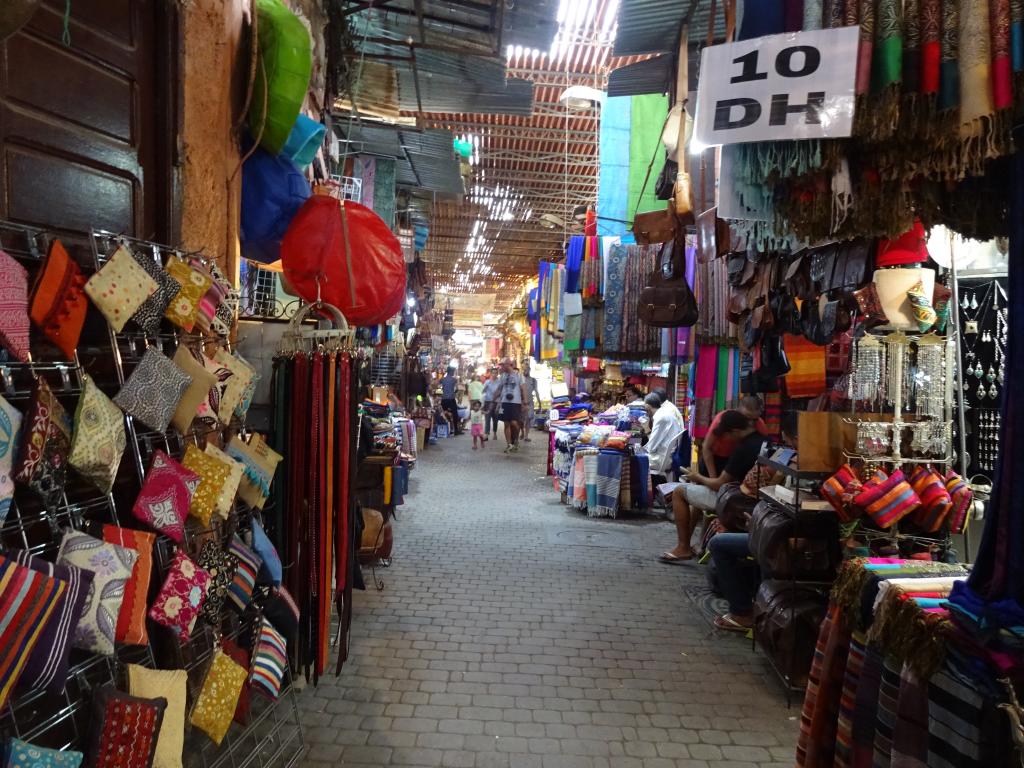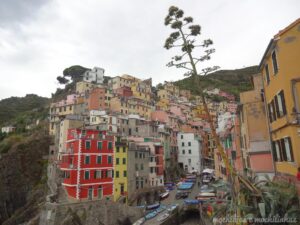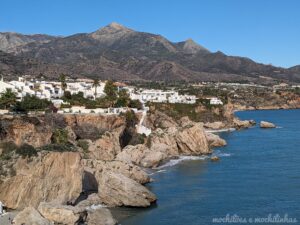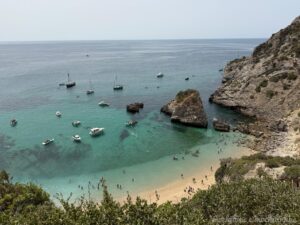Morocco has never been a priority in our bucket list, but when I saw that RyanAir had cheap tickets there, it was just a matter of time to convince Celo and we actually went! I bought the guide TOP 10 Marrakech and I found it really helpful because of the tips, details of the attractions and maps, all very well summarized. I learned a lot by reading the guide and blogs too, but there are things we only learn in practice, right?
If you want to know all the details of our trip, read this link here.
Here are some tips for you:
1) The city is safe.
I know that traveling to poor countries can be a bit nerve-wracking, but I want to say that I found Marrakech to be extremely safe. I didn't see any trouble, and the city isn't very organized... According to the owner of our Riad, safety is one of the country's best features, so you can travel there with peace of mind. As in any tourist city, you always have to be careful about pickpockets, but everyone already knows that (I hope, right...).
2) The traffic is chaotic, but we didn't see an accident.
I think what caught our attention most in Marrakech was the traffic. The streets in the old part of the city are very narrow and, to our surprise, are two-way. There are no pedestrian or bicycle lanes, so you will have to walk alongside the motorbikes, mopeds, tuk tuks, bicycles and even donkeys, always being careful not to trip over the merchandise displayed outside the stores. If you want to cross the street, don't count on drivers to be polite and let you have the right of way: they won't. Always walk on the right and pray that everything goes well. We almost got run over a few times, as we saw some tourists almost get hit, but incredibly we didn't see any accidents. In the city's main square, Jemaa El Fna Square, It's hard to understand what's a street and what's a square, so pay extra attention. Good luck! 🙂
3) The currency is the Dirham, but Euros are accepted in some places.
We took euros and exchanged part of it at the airport (AL BARID BANK had the best exchange rate) and the rest at a bank near the main square. The exchange rates we found were on average 1 euro – 10.75 dh, but in some shops they accepted euros at an exchange rate of 1-10, which is not bad at all.
4) The city is hot and dry.
Thank God Marrakech is dry! Imagine the 40 degree heat with humidity (just think of Rio de Janeiro in the summer...horrible!)? The foreigners wouldn't be able to handle it (we Brazilians are more or less used to it) and tourism would be very weak, poor things. I thought midday was the worst time for the sun, but I found that the most unbearable time was around 3pm or 4pm (we went at the end of September, I don't know if this changes depending on the month). Plan to be in the shade or by the pool at that time and everything will be fine!
5) Drink plenty of mineral water.
The owner of our Riad said that he drinks tap water and doesn’t get sick, but we didn’t want to take any chances and thought it would be better to just drink bottled mineral water. You’ll find 1.5L or 0.5L bottles on every street corner and they’re usually quite cheap, so take advantage of this to stay hydrated. We saw people getting sick in the heat, so be prepared to drink about 2L a day, easily, easily…
6) If you are a woman, wear modest clothing.
Because it is a Muslim country, Moroccan women wear burqas and scarves, so any woman who doesn't wear this style attracts a LOT of attention. Men stare and even say things when we walk by, so to avoid problems, don't wear low-cut tops or expose your legs. I know the heat is tough, but I think the sacrifice is worth it, right?
7) Do not be alarmed by the calls to prayer (Adhan).
If you are staying in the old part of Marrakech (Medina) as we are, you will hear an annoying and loud noise 5 times a day, every day of the week. Maybe you can hear it in the new part of the city too, I don't know. Anyway... this noise is the combination of several men speaking into loudspeakers on the minarets (mosque towers) with the aim of calling only men to pray inside these buildings. The men designated for these calls are the muezzins. It's a noise that's too annoying and too frequent for my taste, especially because the first call is around 6 am (I woke up one day) and the last one is around 10 pm.
8) There are people wanting to make money all the time.
Although there is no violence in the city, it is quite common to find people trying to get you to take the wrong path so they can be your guide later. We saw many guys showing foreigners the wrong direction to attractions and thanks to François, the owner of our Riad, we didn't fall for this scam. They do this so you get lost and they can come and help you later, of course charging you a fee. This is not for anything more serious like kidnapping, for example. So, here is a tip from our French host: no street closes because of prayer time (never) and all these boys/men want to make money, that is, there will be no free help. If you are really lost, ask a store clerk for help, as it is much more likely that it will be free and that they will have no interest in leading you down the wrong path.
9) The service in restaurants is bad.
We went to a few restaurants during the 4 days we were in the city and practically all of them had bad service. It's not that bad, but it's really slow, you know? They take a long time to bring the menus, they take a long time to take the orders, they take a long time to bring the bill, but at least the dishes don't take that long to be prepared and everything we ate was great. It's worth it!
10) The dishes are always the same.
In every restaurant we went to, we saw a variety of tajines and couscous and all the ones we ordered (chicken, lamb and beef) were great. In addition to these two typical dishes, we also tried briouettes (they look like esfihas), tablets, the soup Harira and the coconut biscuit (photo below) from a girl in the middle of the street. Oh, Celo tried their mint tea and liked it too.
11) Most tourist restaurants have Wi-Fi.
If you need Wi-Fi, restaurants are a good option! Always check before you go in, but I can tell you that all of our restaurants had it. They don’t leave the passwords on the menu for anyone to see, but they always tell you when you ask while you’re sitting at your table. At their speed, right?
12) The snacks are delicious and free.
In every restaurant we went to, the waiters brought surprise snacks with our drinks. Delicious breads and seasoned olives that always went well with the fresh orange juice. Both were always complimentary, even when the restaurants had appetizers on the menu.
13) It is very difficult to find alcoholic drinks in restaurants.
We read on some blogs that hotels and restaurants serve alcohol to tourists (Muslims are not allowed to drink), but only ONE restaurant we went to sold it. I don’t know if we chose poorly or if it really is something rare, but we made sure to try the local products…
14) Moroccan beers and wines are good!
We tried two Moroccan beers – Casablanca and Special – and because they are very light, they went down really well in the heat of almost 40 degrees. We drank Moroccan wines at night at the Riad and they were also delicious. The owner of the Riad explained to us that since Morocco was French territory for a few decades, the French brought their knowledge of viticulture (vineyard production) and winemaking (wine making) and that is why the production in the country is good. Enjoy!
15) Orange juice is the most common drink.
In the city's main square, there are several kiosks selling fresh orange juice, but I confess that I was afraid to try it because I had read some reports of people who had gotten sick. On the other hand, I drank orange juice with all my meals in the restaurants and in the Riad, and I didn't taste any bad juice...
16) Tip of 10% is expected.
Self-explanatory, right?
17) It is very rare to see women working.
In every restaurant we went into or passed by, we saw only men serving tables. From what I could tell, 99% of the people who work with the public in Marrakesh are men. We found some women tattoo artists in the main square (they were crazy!!) and also cleaning our hotel, but other than that, nothing else. I find this quite sad, but it's part of the culture, right?
18) The Riads are very cozy.
In the city center, the most common type of accommodation is Riyadh. It is a traditional house or palace and inside there is always a garden and/or central courtyard without a roof. There are no external windows, like in the houses we are used to seeing, but this central space allows a lot of air to circulate and the temperature inside the Riad is very pleasant, even in the hottest hours. I loved ours in many aspects (especially the decoration) and I will talk more about it in post with our itinerary through the city. If you want to see it now, we stayed at Riad Signature.
19) Breakfast at Riads is continental.
The only thing I think could be better in our Riad is the breakfast. At least in ours, breakfast was served directly to our table and we only had a few options, you know? I'm one of those people who loves breakfast and those banquets with a thousand options make my day, so if you find a Riad like that, let me know so I can recommend it here (and maybe come back one day).
20) The souks (markets) are very interesting.
Near the city's main square is the region of souks, which are huge markets with intertwining streets, forming a large labyrinth. I will try to describe it better…
Think of a narrow street and stands glued together on both sides of this street. Put a piassava roof or something similar on top of these stands. Put a lot of merchandise of a certain type on sale and leave only one or two salespeople serving. Now add a lot of people walking and talking at the same time, with no control over direction. Oh, and besides the stands legalized, there are street vendors circulating all the time on this street. To top it off, imagine that all the prices are stupidly thrown up there and that all the buyers negotiate the prices with the vendors. Now look at this scenario every day, all day long, until late at night. There is a lot of movement, a lot of negotiation, it is very hot, in other words, it is tiring physically and emotionally as well. You have to go relaxed, thinking about negotiating and walking calmly. We got discounts of 20/30 euros in some places, but in others we tried to lower the price a lot and the vendors refused. It's part of the game. I loved the products, the colors, (some) smells, the movement, but Celo already thought it was a nightmare... It depends on each one, right?
21) Almost everything is a big negotiation.
I mentioned the markets above, but that's not the only place you'll need to trade: taxi drivers They charge tourists absurd prices and you should always ask before getting in the car. ALWAYS. They even have taximeters, but they don't use them with tourists, so ask in advance at the Riad/hotel for fair prices for your desired destinations and always have change (they never have change). In addition to the taxi drivers, we also had to negotiate with the snake charmers in the middle of the square (we just wanted to watch from afar and not pay anything, but it got confusing) and in some stores around the city. We only didn't negotiate in the Riad, tourist attractions and restaurants. That would be too much, right? 🙂
22) Taxis to the airport have a fixed price.
Good news for tourists! No need to stress about negotiating a taxi to the airport. The price is fixed and is clearly displayed in the airport parking lot (70 dh. at our time – September 2016). We booked directly with the Riad, but I think you can also get that price on the street… I’m not sure. Just in case, book with the Riad, right?
23) Be careful with henna tattoos.
In the main square, you will find many women who get the famous henna tattoos, which are really beautiful. They are crazy and walk towards you with their syringes on display! It's horrible! We saw many people getting tattoos with them, but we didn't want to risk it because the owner of our Riad said that the ink used is a toxic mixture. We saw this information on some blogs and in the guide too, so why take the risk, right?
24) There are cats everywhere.
We saw many cats on the streets and they are incredibly unafraid of humans (a good sign!) and the chaotic city traffic. They walk peacefully through the alleys and lie down in the most diverse places possible, always with little bowls of food, water and milk nearby. On the other hand, we only saw one dog during the whole trip… could it be a cultural thing?
25) Animals are exposed in cages and chains.
The cats are free, but several other animals are kept in captivity and are used to extort money from tourists. We saw chained monkeys, caged lizards and turtles, and snakes lying loose on the ground that vendors insist on putting around tourists' necks. If you stop to look at any of these animals, they will charge you for it and you will end up contributing to this sad scenario. We were passing by a snake stall and stopped to take a picture of the Cobra. Sure enough, the guy came over offering another snake to put around our necks and of course we had to pay for it and get rid of the guy. Total rip-off…
26) Tourist attractions are usually very cheap.
We visited some attractions (I'll tell you all the details in the post with our 4-day itinerary there) and paid an average of 1 euro per person to enter them, especially in the old part. They are not very prepared for tourists, since they don't give out explanatory pamphlets and we didn't see any signs explaining anything, so if you don't have a guide (book or person), you'll get lost and will just admire the beautiful architecture. I think it's worth getting information beforehand or hiring a guide...
27) Be discreet when taking photos.
We saw many Moroccans shying away from taking photos of tourists and we confirmed what we read in our guide: they don’t want to be photographed. If you are enchanted by the stalls in the markets and want to take photos of the products, try to be as discreet as possible, because it is quite possible that they will charge you for the photo taken. There are even some stalls with signs saying that you do not take photos. Please respect this to avoid confusion.
28) Bring a pen to fill out the immigration paperwork.
A very useful tip! Both when you arrive and when you leave the country, you will need to fill out a form and give it to the immigration officer. They are very serious and do not leave pens available on the desks, so to avoid wasting time and having to depend on other people, have one with you at both times.
29) The departure lounge has good restaurant and shopping options.
If you have some Dirhams left over, like we did, don't despair: use them at the airport (I don't think you can exchange them back for Euros). There are some restaurants and shops in the departure lounge, so you won't have to go home with this strange and undervalued currency. At Duty Free, we even thought about buying Jameson with the Dirhams because it was much cheaper than in Dublin, but the guy told us that they only accept Moroccan currency for Moroccan products. Nothing beats good Moroccan wines at times like these!
30) The panel with flights and gates is really confusing.
It took us a while to realize that people were sitting around waiting for their flights without knowing where their boarding gates were. They only announced the gates at the last minute, but this wasn't a problem since the airport isn't very big. Just be alert and board in peace!
That’s it! If you want to know more about what Morocco has to offer, take a look at the tours offered by Civitatis below:











4 responses
Congratulations! We are on our way to Marrakech and your information will be very useful. We will be there for exactly four days.
Hello, I just discovered your blog and I'm in love =)
Thank you for the feedback!! 🙂 I write from the heart!
Very interesting!! I find everything written here charming due to its form and simplicity. Thank you